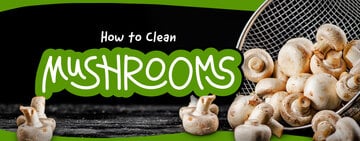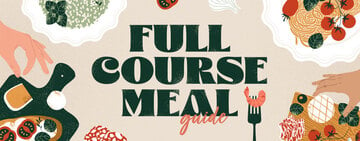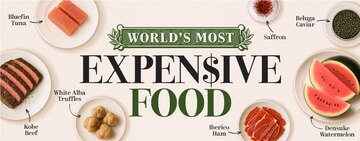Truffles are spores that grow on fungi near tree roots, and their earthy flavor is coveted in the culinary world. These elusive delicacies grow underground in parts of Europe, Australia, and North America, and they are harvested by trained dogs or pigs. Despite their small size, truffles are expensive due to their rarity and labor-intensive harvesting process. Whether you're a chef looking to elevate your menu or a food enthusiast wanting to explore new flavors, read on to learn more about the taste of truffles, where they grow, how much they cost, and different uses for various types.
Shop All Truffle ProductsAre Truffles Mushrooms?
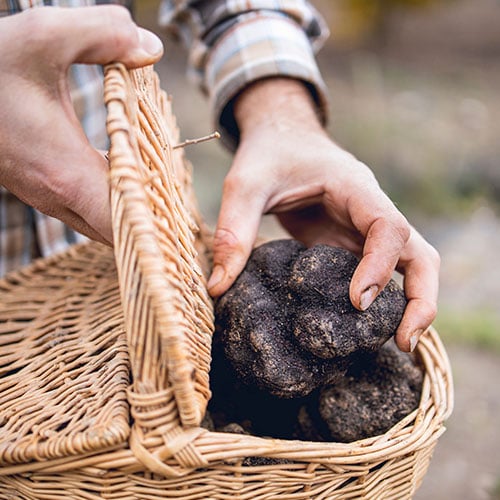
Although truffles are often associated with mushrooms, they have several key differences. Though mushrooms and truffles are considered fungi, truffles are edible spores that grow from Tuberaceae fungi. While mushrooms grow above ground, these unique delicacies grow underground in regions like France and Italy. Additionally, mushrooms are relatively common, but truffles are finicky and require a specific environment to cultivate.
Most truffles used in high-end dining are found among subterranean tree roots in Perigord, France, and Piedmont, Italy, but black truffles grow throughout Europe. Harvesters use truffle hunters, or specially trained dogs and female pigs, to sniff out and dig up the spores. Because of their rarity, distinct flavor, and harvesting challenges, truffles are considered a delicacy with a price tag to match.
What Do Truffles Look Like?
A truffle's size ranges from a pebble to a baseball, and white and black truffles tend to be spheres or ovals. White truffles resemble a light brown potato with a bumpy, rough exterior and pale, grainy flesh. Though not nearly as misshapen as white truffles, black truffles also have a textured, dark shell with a gray-brown interior. They tend to be more symmetrical than their counterparts. Look for firm truffles that are still soft enough to shave.
What Do Truffles Taste Like?
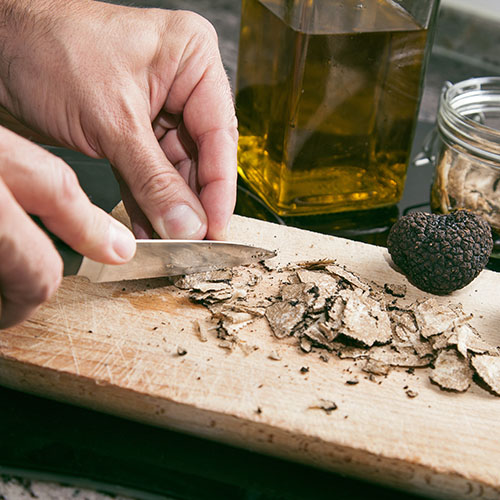
“Earthy” is the main word people use to describe a truffle's flavor. The nutty, umami taste is intense, so use it sparingly to avoid overwhelming the other flavors in a dish. Many savory dishes pair well with truffle, ranging from truffle fries to risotto to boudin blanc.
How Long Do Truffles Last?
Another complication involved with truffle harvesting is their short shelf life. Truffles lose quality immediately after harvesting and last less than five days under perfect storage conditions. Here are some tips for storing truffles to ensure they remain fresh.
- Before storing truffles, wash any dirt or sand off with cool water and dry them with a clean paper towel.
- Wrap truffles individually in clean paper towels and place them in a clean, airtight container.
- Keep fresh truffles in a cool environment, such as a refrigerator, but be careful not to freeze them. If you’re using them immediately, keep them at room temperature to preserve the flavor.
- Rewrap every truffle in a fresh paper towel every 24 hours until use.
What Is Truffle Oil?
Due to the high price of fresh truffles, many restaurants use truffle oil to provide their dishes with the umami truffle flavor. This versatile oil comes from infusing extra-virgin olive oil with raw truffle, providing a solution with a longer shelf life than the spores themselves. Much like raw truffles, different truffle oils have different flavors, prices, and uses. White truffle oil is a key ingredient in pasta sauces, while black truffle oil is a garnish for steak and other meat.
If you prefer alternatives to oil, truffle butter is another substitute that works well with creamy dishes. As the name implies, truffle butter is fresh butter with truffle shavings blended in the cream to provide that rich flavor.
Black Truffle vs White Truffle
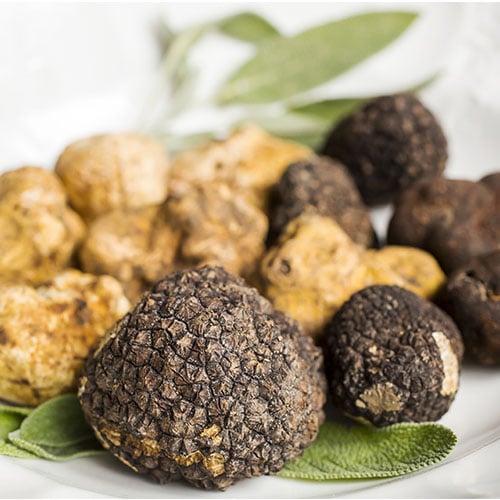
While there are many types of truffles, most are categorized as either black truffles or white truffles. They grow in different regions with varying tastes, uses, and prices. We compared black and white truffles to help you find the right type for your establishment.
Black Truffle
If you have truffle dishes featured on your menu, you probably use black truffles for most of them. Since they are easier to cultivate and find than white truffles, they are less expensive than their counterparts. Farmers and foragers uncover these truffles mingling in hazelnut, oak, pine, poplar, and beech tree roots. Distinguished by their black outer shell and intense taste, black truffles are present in various savory dishes and seasonings in many upscale establishments.
Region: France (Perigord), Spain, Australia, Pacific Northwest
Season: December to March, May to August for summer truffles
Price: Average $1k to $2k per pound
Common Types: Black winter truffle, burgundy truffle, black summer truffle, Perigord black truffle
White Truffle
Unlike black truffles, white truffles cannot be cultivated and are extremely hard to find. Their rarity increases prices, making white truffle dishes only available at high-end restaurants or in regions with an abundance of white truffles. With a slightly more subtle flavor than black truffles, they pair well with pasta dishes rather than meat entrees.
Region: Italy (especially Piedmont), Southern Hungary, Serbia
Season: September to December
Price: Average $4k to $6k per pound
Common Types: Alba truffle, Bianchetto truffle
Why Are Truffles So Expensive?
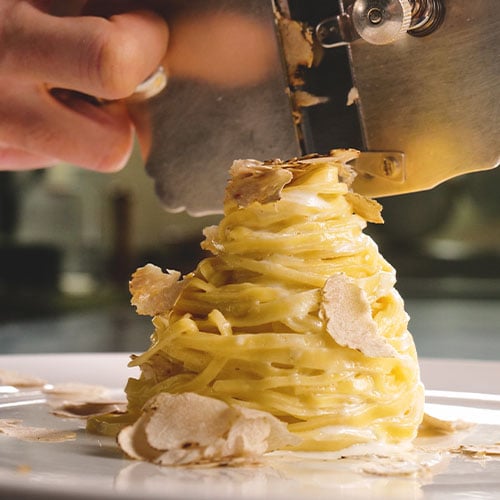
The association of truffle dishes with high-end dining is not a coincidence. A single truffle can cost up to $100, while a pound of white truffles costs nearly $5,000. In 2014, a white truffle weighing almost 6 pounds sold in New York for $61,000. Restaurants relying on truffles for their menu items incur heavy costs to supply their kitchen, and here are a few reasons why truffles are so expensive.
- Scarcity: Due to the difficulty in finding and harvesting truffles, demand for these delicacies is much higher than supply. Their limited availability drives up prices, with many going to high-end restaurants willing to pay exorbitant prices.
- High Harvesting Costs: Harvesting truffles is a labor-intensive process that involves specially trained dogs or pigs to sniff out the hidden treasures, which is very expensive. Truffle hunters must carefully dig around the tree roots to unearth the delicate fungi without damaging them. Then, the truffles must be cleaned and packaged before sale, adding to the high cost.
- Short Shelf Life: Truffles begin losing their strong taste immediately after extraction and only last a week before going bad. This limited window means that truffles must be quickly transported from the source to the consumer, adding to the logistical challenges and expenses in distribution.
- Seasonal Availability: While truffles can be found year-round, foragers and farmers harvest most in the fall and winter. This short window further limits supply and makes truffle dishes seasonal commodities, driving up prices.
- Unpredictable Cultivation: While there has been some success growing truffles in an agricultural setting, the process is extremely unpredictable. Farmers must work for 6 to 7 years before yielding a truffle crop, and there’s no guarantee that truffles will grow. To get a return on their investment, farmers charge high prices for their truffles.
- Shipping and Processing Challenges: Many truffles are imported to the US from Europe, so they must follow strict customs guidelines before entering the country. Additionally, buyers must watch out for counterfeit truffles and ensure their food shipment is genuine.
Where to Buy Truffles
Given their high price tag, truffles generate a lot of attention from malicious actors. Counterfeit truffles and truffle smuggling are both prolific in the truffle business, which can hurt your establishment. Buying truffles from vetted sources ensures you get what you need to create your signature dishes.
Use these tips to prevent potential scams when buying truffles.
- Buy from Reputable Sources: There are many established truffle vendors in the foodservice world to choose from when sourcing truffles. Before selecting a vendor, check their background and customer reviews with a fine-toothed comb and make sure they have the proper credentials.
- Ask Lots of Questions: You’re spending a significant amount of money obtaining truffles, so ask the vendors questions about the truffles to ensure they meet your standards. If they can’t answer your questions, find a different source.
- Inspect Packaging and Products: Some truffle sellers will watermark their packaging to prove their products are authentic and will properly wrap them to preserve quality. Additionally, sniff the truffles and check for defects before using them.
- Stay Updated on Industry Standards: Knowing the going rate for truffles allows you to spot malicious actors offering truffles for less than market value. If a deal looks too good to be true, it probably is.
- Buy In-Person When Possible: While there are many online reputable truffle vendors, nothing compares to buying your truffles in person. You can verify the quality of the product yourself, ensuring that everything passes inspection before paying.
How to Cook with Truffles
Due to their dominant flavor profile, truffles are not the primary ingredient of cooked dishes. Rather, chefs will use them as a garnish or dilute them with sauce. Some restaurants infuse the truffle taste in foods by storing truffles with them or by cooking them in truffle oil.
Below are a few options for how to use truffles in your cooking. However, do not cook truffles for long or they will lose flavor.
- Shave truffles on top of cooked entrees, such as risotto, gnocchi, seafood, or steak
- Make omelets from eggs stored with truffles
- Add truffle shavings to sauces and mix with pasta
- Season dishes with truffle salt or truffle oil
- Blend truffle with butter to create truffle butter
If you’re looking for something to make your menu pop, consider adding some signature truffle dishes to your offerings. A black truffle steak or white truffle risotto adds a dash of exclusivity to your establishment that appeals to food lovers. While acquiring truffles is expensive and challenging, this exciting addition that enhances your dishes is worth the cost.

